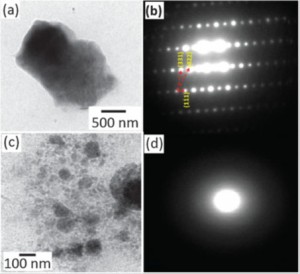 Doping various mineral oxides with lanthanide ions is one of the big trends at the moment. Possibly because of the wide application of lanthanide ions in lighting, bioanalysis and telecommunication, possibly because all you need is an oven and a big laser in order to study something as interesting as the processes in the lanthanide excited state manifold.
Doping various mineral oxides with lanthanide ions is one of the big trends at the moment. Possibly because of the wide application of lanthanide ions in lighting, bioanalysis and telecommunication, possibly because all you need is an oven and a big laser in order to study something as interesting as the processes in the lanthanide excited state manifold.
Singh and co-workers have doped an yttrium titanium oxide with erbium an ytterbium and studied the luminescence following energy up-conversion. Subsequently, they used laser ablation to pulverise the mineral and studied the powder. Most intriguing, they find that the amount of red and green light emitted vary as a function of laser power.
Lanthanide luminescence, originating from f–f transitions, where the only the f-electron configuration changes, is intriguing as it can occur all across the spectrum, from numerous excited states to multiple other excited states, some of which may even be emissive as well.
While organic chromophores have one ground state, one excited state and a triplet state wherein the molecule may stay for more than picoseconds, lanthanide ions have several if not many. Ytterbium is the only exception, with only one; a consequence of the nearly full f-shell. The shielded nature of the f-orbitals allow for slow processes in the excited state manifold, where the excited states are only quenched by high-energy phonon or vibrational modes in the surroundings. Thus, although energy up-conversion is possible through several pathways, excited state absorption usually dominates.
“Structural and up-conversion properties of Er3+ and Yb3+ co-doped Y2Ti2O7 phosphors” by B. P. Singh , A. K. Parchur , R. K. Singh , A. A. Ansari , P. Singh and S. B. Rai is a comprehensive study of the photophysics of erbium and ytterbium doped in a solid state lattice. For the full account see issue 10 of PCCP: Phys. Chem. Chem. Phys., 2013,15, 3480-3489.
by Dr Thomas Just Sørensen










